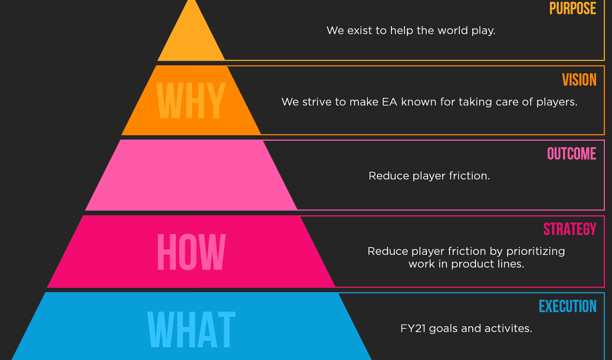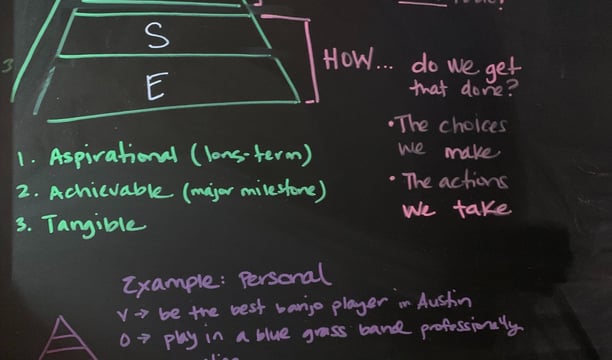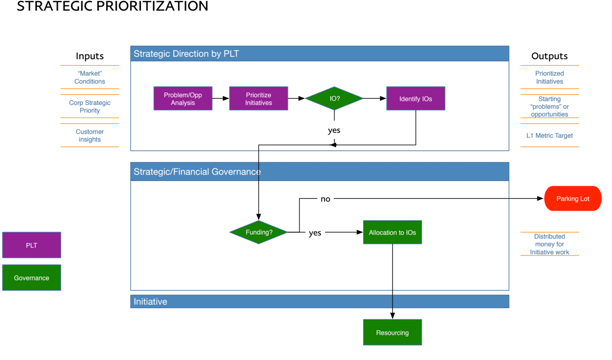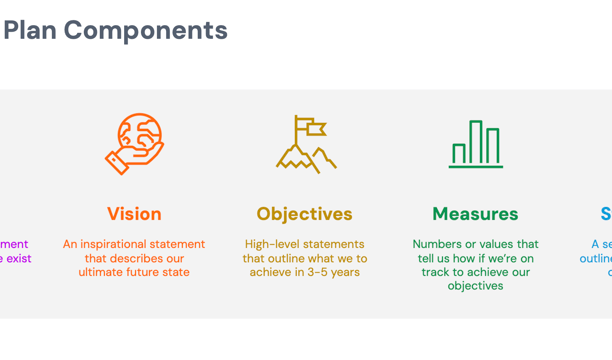STRATEGIC PLANNING
I bring deep experience in leading and supporting strategic planning efforts that translate vision into actionable outcomes. My approach is grounded in helping teams define clear long-term goals, identify key opportunities, and align resources to drive meaningful progress.
Whether building a team’s first strategic plan or refining an existing one, I foster alignment through inclusive collaboration, structured facilitation, and thoughtful communication. I ensure strategies remain connected to business objectives while staying adaptable to change.
EA Customer Service
Problem:
EA’s Customer Service organization lacked a formal strategic planning process, resulting in blurred lines between operational execution and long-term strategic initiatives. Teams were routinely overextended, juggling both tactical demands and strategic work without clarity on priorities, leading to misalignment, reduced effectiveness, and capacity strain.
Approach:
To address this, I introduced a comprehensive strategic planning framework that brought structure, discipline, and clarity to how the organization approached its priorities. I guided the team in defining distinct work types—strategic, operational, and ad hoc—and established a repeatable planning process to align initiatives with broader organizational goals. This included resource mapping, timeline planning, and cross-functional alignment to ensure the right teams were focused on the right work at the right time.
Outcome:
The new strategic planning model created a clear distinction between operational and strategic efforts, improving decision-making, visibility, and resource allocation across the organization. It enabled leadership to more effectively prioritize initiatives, empowered teams to focus without unnecessary context-switching, and ultimately elevated the Customer Service function’s ability to deliver both daily support and long-term impact with greater precision and agility.






EA Customer Service Strategic Planning Evolution
Problem:
EA’s Customer Service organization faced growing complexity and lacked a cohesive, enterprise-level approach to strategy creation, project alignment, and resource prioritization. Without a unifying framework or clear metrics, teams struggled to focus efforts, measure impact, and scale initiatives effectively across a 500+ person organization.
Approach:
Over a two-year period, I led the development and implementation of a comprehensive strategic planning system tailored to the unique demands of the Customer Service organization. This included establishing a clear strategy framework, aligning projects with enterprise priorities, and introducing OKRs (Objectives and Key Results) to drive measurable, outcome-oriented execution. To embed the strategy across all levels of the organization, we launched training initiatives and communication programs to ensure every employee understood how to contribute to and benefit from this system.
Outcome:
The result was a fully integrated strategic planning capability that aligned over 500 employees around common goals, streamlined resource allocation, and prioritized the highest-impact initiatives. The adoption of OKRs introduced clarity and accountability, while the system’s widespread implementation empowered teams to apply strategic thinking in their daily work. This transformation significantly elevated operational focus, cross-functional alignment, and the organization’s ability to deliver on its long-term vision.
PayPal Human Resources Strategic Prioritization
Problem:
The PayPal HR Leadership team lacked a structured, enterprise-wide approach for evaluating and prioritizing incoming initiatives. Without a clear framework to assess alignment with corporate objectives or manage capacity, the team faced challenges in focusing efforts, avoiding duplication, and driving measurable impact across their portfolio of work.
Approach:
Partnering with HR leadership, I led the design and implementation of a streamlined, user-friendly prioritization process. This framework enabled leaders to consistently evaluate new proposals, align initiatives with strategic goals, and build a balanced, transparent backlog for future planning. The process emphasized clarity, repeatability, and cross-functional visibility to support better decision-making and execution.
Outcome:
The new prioritization model transformed how the HR organization approached strategic planning—creating focus, improving alignment, and enabling smarter resource allocation. It also laid the groundwork for measuring the success of key initiatives over time, ultimately helping the team operate with greater agility and impact within PayPal’s broader enterprise strategy.
PayPal UX Strategic Planning
Problem:
The PayPal UX team operated primarily in a service capacity, supporting partner initiatives across the organization. However, the team lacked a structured planning process to distinguish between externally driven work and the internal investments needed to improve their own operations. As a result, internal priorities were often deprioritized, limiting opportunities to scale, innovate, and optimize team performance.
Approach:
I introduced a structured strategic planning framework that enabled the UX team to clearly define, categorize, and prioritize both partner-facing projects and internal initiatives. By establishing a process that balanced external delivery with operational investment, we ensured the team could support business demands while continuously improving its own effectiveness. The model included visibility tools and planning cadences that promoted alignment, ownership, and data-informed decision-making.
Outcome:
The new approach empowered the UX team to operate with greater clarity, balance, and strategic intent. It created space for internal innovation, improved workflow efficiency, and enabled more deliberate investment in long-term capability building—all while maintaining high-quality support for cross-functional partners. The result was a more resilient, focused, and strategically aligned design organization.



